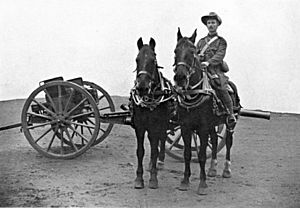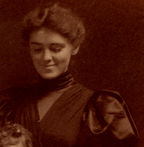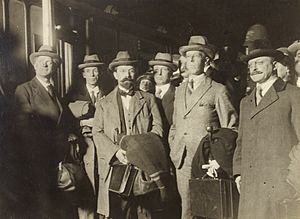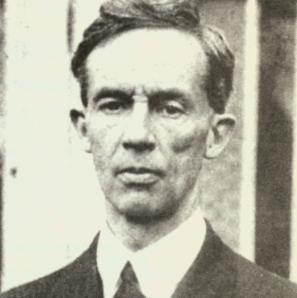Erskine Childers (author) facts for kids
Quick facts for kids
Erskine Childers
|
|
|---|---|

Childers in uniform of the City Imperial Volunteers (CIV), 1899
|
|
| Teachta Dála | |
| In office May 1921 – June 1922 |
|
| Constituency | Kildare–Wicklow |
| Personal details | |
| Born |
Robert Erskine Childers
25 June 1870 Mayfair, London, England |
| Died | 24 November 1922 (aged 52) Beggars Bush Barracks, Dublin, Ireland |
| Cause of death | Execution |
| Resting place | Glasnevin Cemetery, Dublin, Ireland |
| Nationality | Irish |
| Political party | Sinn Féin |
| Spouse | |
| Children | 3, including Erskine |
| Parents |
|
| Relatives |
|
| Profession | |
| Known for | Navigation |
Robert Erskine Childers (born June 25, 1870 – died November 24, 1922) was an Irish writer, politician, and activist. He was born in England but became a strong supporter of Irish independence.
Childers wrote a famous adventure novel called The Riddle of the Sands. He also became known for secretly bringing guns into Ireland on his sailing yacht, the Asgard. He was the father of Erskine Hamilton Childers, who later became the fourth President of Ireland.
Contents
Erskine Childers' Early Life
Erskine Childers was born in Mayfair, London, in 1870. His father, Robert Caesar Childers, was a scholar who studied languages. His mother, Anna Mary Henrietta Barton, came from an Irish family.
When Erskine was six, his father passed away. His mother died six years later. Erskine and his four brothers and sisters went to live with their mother's uncle in Glendalough, County Wicklow, Ireland. He grew up loving Ireland.
Childers went to Haileybury College and then to Trinity College, Cambridge. He studied law and became the editor of the university magazine. He also became president of the Trinity College Debating Society.
After college, Childers worked in the British Parliament. He helped prepare new laws.
Sailing Adventures
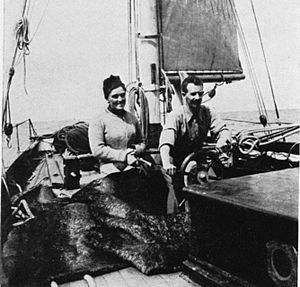
Because of an injury, Childers could not play rugby. His friend, Walter Runciman, encouraged him to try sailing. Childers bought his first small yacht, the Shulah, in 1893. He learned to sail it by himself.
He later bought a small sailing boat called a Water Wag. He sailed it on Lough Dan near his home in Glendalough. He also sailed bigger boats across the English Channel. In 1897, he took a long trip to the Frisian Islands and the Baltic Sea with his brother Henry.
These sailing trips inspired his most famous book, The Riddle of the Sands, published in 1903. It was a huge bestseller. In 1903, Childers and his new wife, Molly Osgood, sailed in the Frisian Islands. Molly's father gave them a beautiful yacht called Asgard as a wedding gift.
The Asgard and Gun-Running
The Asgard became Childers's most famous yacht. In June 1914, he used it to secretly bring 900 rifles and 29,000 bullets to the Irish Volunteers movement. This happened at the fishing village of Howth, County Dublin.
The Asgard is now kept at The National Museum of Ireland. It is an important part of Irish history.
War Service
Childers initially believed in the British Empire. He joined the City Imperial Volunteers during the Second Boer War in South Africa in 1900. He was an artilleryman, caring for horses and helping with ammunition.
He saw action in South Africa and was later sent to a hospital with a foot injury. During his recovery, he met Irish soldiers. He noticed their loyalty to Britain.
First World War Service
By the start of the First World War, Childers's views on Britain had changed. He had left the Liberal Party because of delays in Irish self-rule. He had also written books criticizing British policy in Ireland.
Even though he had smuggled guns for Irish nationalists, Childers volunteered for naval service in August 1914. Winston Churchill helped him join the Royal Naval Reserve. Churchill believed Childers's book, The Riddle of the Sands, had helped convince people to fund the British navy.
Childers helped plan an invasion of Germany. He also served as a navigator and observer on seaplanes. He took part in the Cuxhaven Raid in 1914. In 1915, he served in the Gallipoli Campaign and earned a Distinguished Service Cross.
He later worked at the British Admiralty in London. In 1918, he joined the new Royal Air Force as a major. He helped prepare navigation plans for bombing attacks. He left the Royal Air Force in March 1919.
Marriage and Family Life
In 1903, Childers visited the United States. He met Mary Alden Osgood, known as Molly, in Boston. She was a wealthy and well-read woman. They got married in Boston on January 6, 1904.
Molly influenced Childers's views. She helped him move away from his belief in imperialism. They lived in Chelsea, London, for many years. Childers worked in Parliament and continued his writing.
Molly loved sailing, even though she had weak legs from a childhood injury. They sailed often on the Asgard. Childers's letters show how happy they were together. They had three sons: Erskine (born 1905), Henry (born 1907, died young), and Robert Alden (born 1910).
Writing Career
Childers's first published works were short detective stories for the Cambridge Review.
Books About War
His first book, In the Ranks of the C.I.V., was about his experiences in the Boer War. He wrote it as letters to his sisters. They helped edit the letters into a book, which was published in 1900. It sold very well.
Childers also edited a book about his regiment's role in the Boer War. He later wrote a volume for The Times' History of the War in South Africa. In this work, he pointed out mistakes made by the British.
The Riddle of the Sands
Childers started writing his famous novel, The Riddle of the Sands, in 1901. It was published in May 1903. The book was based on his own sailing trips along the German coast. It warned about a possible war with Germany and urged Britain to be prepared.
The book was very popular and has never stopped being printed. It is considered one of the first spy novels. It influenced many other writers and even helped convince the British Admiralty to build new naval bases.
The Framework for Home Rule
In 1911, Childers wrote The Framework for Home Rule. In this book, he argued that Ireland should have its own parliament and control its own money, like Canada. He believed this would benefit Ireland.
Childers thought that people in Ulster who opposed self-rule would change their minds. However, he was wrong. Their opposition, partly due to religious differences and economic concerns, later led to the Partition of Ireland in 1921.
Change of Views and Irish Politics
Childers's views changed over time. He became convinced that Ireland should have its own government. He realized that the Boer War could have been avoided. His friend, Basil Williams, noticed his growing doubts about Britain's actions.
Molly Childers, with her American background, also influenced his ideas about countries ruling themselves. In 1908, he toured Ireland and saw the poverty. He wrote that he was now "finally and immutably a convert to Home Rule."
In 1910, Childers left his job to join the Liberal Party, which supported Home Rule for Ireland. He even became a candidate for Parliament. However, when the party considered excluding parts of Ulster from self-governed Ireland, Childers left the party.
The Home Rule Bill was passed in 1914 but was put on hold because of the First World War.
Joining the Irish Cause
The harsh response to the Easter Rising in 1916 upset Childers. He saw a British plan to force Irish men into the military as "insane and criminal." In 1919, he went to his old home in Glendalough to rest. There, his cousin Robert Barton introduced him to Irish leaders Michael Collins and Éamon de Valera.
Childers became the Director of Publicity for the First Irish Parliament in 1919. In 1920, he wrote Military Rule in Ireland, criticizing British policy. In the 1921 Irish elections, he was elected to the Second Dáil for the Kildare–Wicklow area. He also became editor of the Irish Bulletin.
Irish Civil War
Childers was part of the Irish team that negotiated the Anglo-Irish Treaty with the British Government in London in 1921. He strongly opposed the final agreement, especially the part about Irish leaders swearing loyalty to the British monarch. He believed Ireland was giving up its independence.
The Dáil debated the treaty. Childers argued against it. Some, like Arthur Griffith, accused him of trying to destroy the agreement. However, the Dáil voted to accept the treaty by a small margin.
The treaty divided Irish nationalists. This led to the Irish Civil War on June 28, 1922. Childers sided with the anti-treaty forces. He helped produce their news sheet, War News.
Arrest and Trial
After Michael Collins was killed, the Free State authorities wanted to stop the rebellion. On September 28, 1922, a new law made carrying firearms without a license a crime punishable by death.
In November 1922, Childers decided to join Éamon de Valera. He cycled from Kerry to his old home in Glendalough. On November 10, Free State forces arrested him there.
Childers was put on trial by a military court. He was charged with having a small pistol, which had been a gift from Michael Collins. He was found guilty and sentenced to death on November 20, 1922.
Childers appealed the sentence, but the judge said the court could not help him because of the civil war. His lawyer appealed to the Supreme Court, but Childers was executed before the appeal was heard.
Execution and Legacy
Erskine Childers was executed by firing squad on November 24, 1922, at Beggars Bush Barracks in Dublin. Before his execution, he shook hands with the firing squad. He also asked his 16-year-old son, Erskine Hamilton Childers, to shake the hand of everyone who signed his death sentence. His last words to the firing squad were: "Take a step or two forward, lads, it will be easier that way."
Childers was first buried at Beggars Bush Barracks. In 1923, his body was moved and reburied in the republican plot at Glasnevin Cemetery.
Winston Churchill said that Childers had caused great harm to Ireland. However, Éamon de Valera said Childers was "the noblest" man he had ever met.
Molly Childers wanted her husband's papers to be kept private for 50 years after his death. In 1972, their son, Erskine Hamilton Childers, began the process of finding someone to write his father's official biography. The biography was published in 1977.
Dramatisations
Erskine Childers's life has been shown in plays and TV shows:
- In 1991, Bosco Hogan played Childers in the TV show The Treaty.
- In 1998, BBC Radio 3 broadcast a play called A Flag Unfurled, based on Childers's life. Michael Maloney played Childers.
- In 2011, a TV series called Bású na gCarad (The Friends' Execution) included Childers's arrest and trial. Dominic Frisby played Childers.
See also
 In Spanish: Robert Erskine Childers para niños
In Spanish: Robert Erskine Childers para niños


